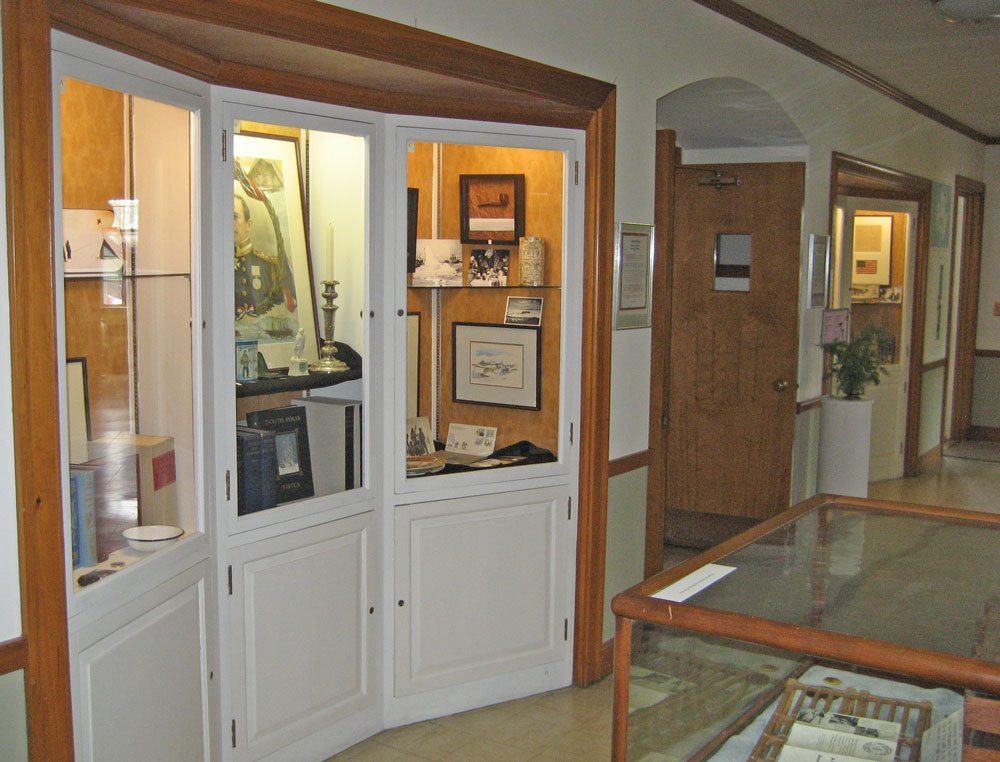Antarcticana
From the Collection
of
Robert Stephenson
GUIDE TO ITEMS
DISPLAYED
Jaffrey Civic Center
June 1-28, 2012
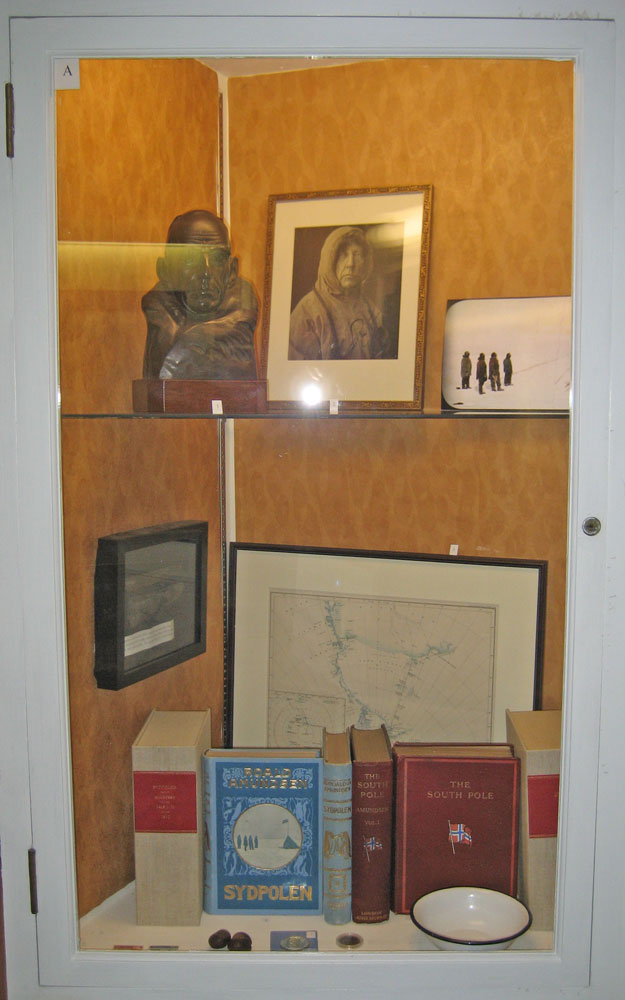
CASE A:
Captain Roald Amundsen
[Amundsen, with
his companions, was the first to reach the South Pole in December of 1911.]
1.
Bronze bust of Roald Amundsen by the Norwegian-American sculptor, Trygve
Hammer, c. 1930s. Purchased from Floyd T. McLaughlin, Ohio, in 1974.
2.
Autographed black and white photographic portrait of Roald Amundsen. Purchased
from F. P. Elwert, Vermont, in 1972.
-
Amundsen and his fellow explorers at the South Pole, December 17, 1911.
-
Although associated with the Arctic, this knife is too interesting not to
include. Amundsen gave it to Lincoln Ellsworth who gave it to Beekman Pool of
Dublin who, in turn, gave it to me. It was used by Amundsen and Ellsworth to
flatten the ice so that their plane could take off from an ice floe and return
them to Norway. It was probably made by Martin R�nne who was a member of
Amundsen's South Pole expedition and was also on Byrd's 1929 expedition.
3. Map Route
of Captain R. Amundsen's South Polar Expedition 1911-1912. From the Geographical Journal, 1913.
London: Royal Geographical Society. Purchased from the Map House, London, 1998.
4. Amundsen's
account of his South Polar
expedition, The South Pole,
first English edition, 1912. Purchased at auction in 1970 for $18!
5. Sydpolen;
den Norske Sydpolsfaerd med Fram 1910-1912, first Norwegian edition, 1912. Purchased from Explorer
Books, 2000.
- Norwegian
stamps featuring Amundsen, 45 ore and 90 ore. Issued in 1961.
6. Two chestnuts
from chestnut tree in the front yard of Amundsen's house in Svartskog, Norway.
The tree was said to have been there during Amundsen's life.
7.
South Polar Diamond Anniversary Medal issued by the Canterbury Museum, New
Zealand, in 1971-1972. Scott appears on one side, Amundsen on the other.
Purchased from Explorer Books, England, 1999.
8. Silver 5
Kroner Norwegian coin showing King Harald V on one side, Fram on other. Issued 1996.
9. Fram bowl. Unfortunately this is a
reproduction purchased at the Fram Museum in Oslo.
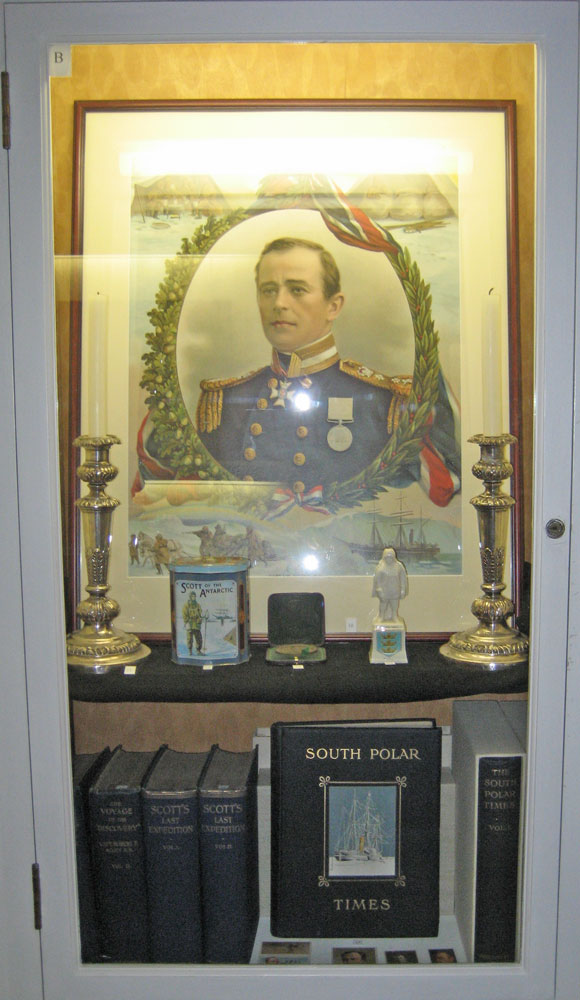
CASE B -
Captain Robert Falcon Scott I
[Scott, with his
companions, reached the South Pole on January 17, 1912, only to find Amundsen's
tent and learn that they had lost the "race."]
10.
Color memorial lithograph of Captain Scott. A fine example of the outpouring of
sentiment that followed the polar tragedy. Purchased at a Bob Finch auction,
1999.
11.
One of a pair of Sheffield plate candlesticks owned by Captain Scott, with his
crest. Purchased from Clive Farahar, England, 1986.
12. "Scott of
the Antarctic' tea tin. Purchased on ebay, 2002.
13.
Scott Memorial Medal, struck in bronze by the Royal Geographical Society for
the members of the expedition. Purchased at auction, 1999.
14.
Porcelain memorial statuette of Captain Scott with the seal of Hull.
Other English
cities issued the same statuette. Purchased in England, 1999.
15. Scott's
account of his first expedition. Voyage of Discovery, London, 1905. Purchased from Gaston
Renard, 1971.
16. This first
edition of Scott's Last Expedition,
London 1913, is inscribed by Oriana Wilson, Edward A. Wilson's widow. He died
with Scott on the return from the Pole. Purchased from Blackwells, 1970.
17. South
Polar Times, London 1907
and 1914. During Scott's two expeditions, a "newspaper" was produced for the
amusement of the expeditioners. The single typed copy was passed around for all
to enjoy. Perhaps the chief attraction was Edward Wilson's marvelous illustrations.
The fourth volume, edited by Apsley Cherry-Garrard was a slim volume and lacked
Wilson's art (he was dead at this point, on the return from the Pole). Back in
England the three volumes (two during Discovery and one during Terra Nova) were published in limited facsimile
editions. They are highly collected. The final volume was finally published in
2011. And all the volumes have just been published this year by The Folio
Society. Purchased from Polar Books, 1976.
- Assorted trade
cards featuring Scott and his men. Mostly purchased on ebay.

CASE C -
Captain Robert Falcon Scott II
18. Royal Doulton Toby
mug of Captain c1998. Purchased from Explorer Books, 2001.
19. Wood from
three famous Antarctic ships: the Discovery, the Terra Nova and the Endurance.
20. Captain Scott's pipe, retrieved from
his final tent on the return from the Pole. Purchased from Rhod McEwen at The
Red Lion after a few beers following the Christie's auction, 1999. We bid against each other for the lot of two
pipes, and he won!
21. Photograph
of Scott with his pipe, along with Edgar Evans, Birdie Bowers and Edward
Wilson. (All died on the return from the Pole.)
22. Photograph
of Scott's last tent as it was found by the search party in 1912. A snow cairn
was built over the tent. Where is it now? Read Richard Pierce's Dead Men, available at The Toadstool.
23. An unopened tin of
Fry's Cocoa retrieved from Scott's Cape Evans
hut by Harry
Francis in the 1950s. Back then, it was common to take souvenirs from the huts.
Not so now. Gift of Sharon Francis, 1999.
24. Menu from
the Farewell Dinner of July 6, 1901 given at the Savage Club, London, for
members of the National Antarctic Expedition (Discovery), signed by Scott, Shackleton, Royds,
Skelton, Armitage and others. At least two other Antarctic dinners were held at
the Club with similarly attractive menus. Purchased from Clive Farahar,
England, 1978.
25. With
Captain Scott at the South Pole.
Collectors cards issued by Fry's Chocolate. Series of 25. Purchased from High
Latitude, 1993.
26. Scott's
Hut II [Cape Evans].
Watercolor by Lucia deLeiris of Waltham, Massachusetts, 1997. Purchased from
the artist, 1997. With photograph of hut.
27. Captain
Scott's Message to England,
1913. Purchased from American Library Services, 1977.
- First day
cover. 75th Anniversary of Captain Scott's Arrival at the South Pole - January
1912. British Antarctic Territory.
28. Scott
commemorative plate by Doulton. Purchased from Paul Davies, 2011.
29. Discovery plate. I wish this was an original. If
so, it would have cost a lot more. But this is a reproduction done by the
Dundee Heritage Trust. They use the plates for dinners in the wardroom on the Discovery. That's how I knew about them when I
arranged a dinner there mostly for descendants of Scott's two expeditions.
- Trade card
featuring the marble statue of Scott, sculpted by his widow, in Christchurch,
New Zealand. It fell to the ground and broke into several pieces during the
recent earthquake. The original version, in bronze, stands in Waterloo Place,
London. Purchased on ebay, 2001.
- "In memory of
the Antarctic Heroes." Postcard from 1912.
30. Hairs from
Captain Oates' sleeping bag. The bag is at Scott Polar Research Institute and
the then archivist, Bob Headland, swept up a few stray hairs for me. Oates
("I'm just going outside and may be some time") died on the return from the
Pole.
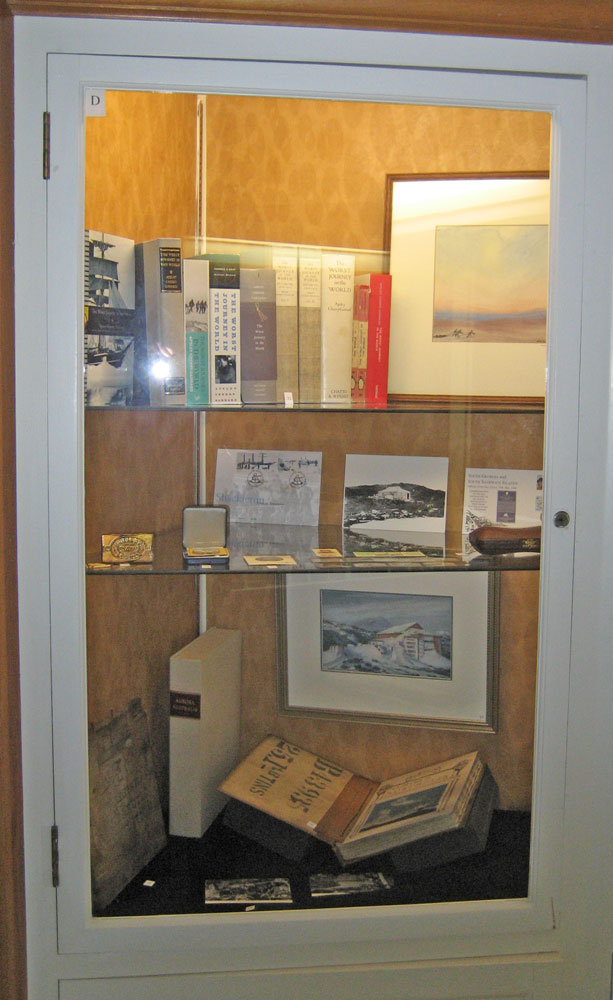
CASE D -
Apsley Cherry-Garrard and Sir Ernest Shackleton
[Apsley
Cherry-Garrard was a member of Scott's Last Expedition. Throughout the rest of
his life he felt guilty for not
proceeding further south and perhaps encountering the remaining three
members of the Polar Party and saving their lives.]
[Sir Ernest
Shackleton was on Scott's first expedition (Discovery). In 1907-09 he led his own very
successful expedition (Nimrod).
His Endurance
expedition is known for its miraculous series of challenges (and for its utter
failure as an expedition). His fourth and final expedition (Quest) was poorly conceived and a failure in
the sense that Shackleton died just as it was getting underway.]
31. Numerous
editions of Cherry-Garrard's Antarctic classic, The Worst Journey in the
World, including the
first edition, 1922. It's never been out-of-print. The Worst Journey refers not
to Scott's tragic polar journey but to the winter journey of Wilson, Bowers and
Cherry-Garrard to Cape Crozier to retrieve Emperor penguin eggs.
32. Minus
Fifties, watercolor by
Apsley Cherry-Garrard, signed by the artist. This scene of three men sledging
depicts the 'Worst Journey' to Cape Crozier that was actually done in winter
darkness. Purchased from Maggs Bros., London, in 1971.
- Irish stamps,
issued 19 March 2004 commemorating the Endurance expedition.
- South Georgia
and South Sandwich Islands Official First Day Cover, 20th May 1996. Commemorating
the 80th anniversary of Sir Ernest Shackleton's trek from King Haakon Bay to
Stromness.
33.
Metal match box with matches retrieved from Shackleton's Cape Royds hut by
Conrad Larson in the 1950s. Gift of Anna Larson, Peterborough, New Hampshire,
1995.
34. Silver
medallion issued in 1972 to commemorate the 50th anniversary of
Shackleton's death. Purchased from the British mint, 1972.
35. �2 silver
coin issued by the Falkland Islands featuring Shackleton with the Endurance on the obverse. Gift of granddaughter
Alexandra Shackleton,1999.
- Trade card
featuring the James Caird,
the boat in which Shackleton and five others sailed the 800 miles from Elephant
Island to South Georgia Island through some of the worst seas in the world.
Purchased on ebay, 2000.
- Trade card
featuring Sir Ernest Shackleton Purchased on ebay, 2000.
36.
Dunhill pipe presented to Sir Ernest Shackleton "by the cabmen of Hyde Park
Corner" in 1921. (Just the case; the pipe is lacking.) Shackleton was
well-known to the London cabbies. He would often end the evening with a cup of
tea in one of their shelters. The one that used to be at Hyde Park Corner was
quite distant from his Kensington house. Why did he drop by there? It turns out
that his "lady friend" lived close by! Gift of granddaughter Alexandra
Shackleton in 2000.
37. Shackleton's
Hut, Cape Royds. Pastel
by Lucia deLeiris of Waltham, Massachusetts. 1997. Purchased from the artist,
2000.
-
Photograph of Shackleton's Cape Royds hut taken by Conrad Larson in the 1950s. Gift
of Anna Larson, Peterborough, New Hampshire, 1995.
38. The Aurora
Australis, the first and
probably only book written, illustrated, printed, bound and issued in the
Antarctic. Produced during Shackleton's Nimrod expedition. There were likely only about
80 copies produced and each one is unique as the book was bound in actual
boards fashioned from the packing cases. Note the stenciling. No Antarctic
collection is considered significant without a copy of this book.
39.
End of wood packing case from Shackleton's Cape Royds hut. Gift of Anna Larson,
Peterborough, New Hampshire, 1995.
40. Photograph
of Ernest Joyce and Frank Wild in the "Rogue's Retreat" where the printing was
done. The press is at the right and the type case is behind Wild's head in the first
photo.
41. Photograph
of Ernest Joyce in the "Rogue's Retreat" where the printing was done.
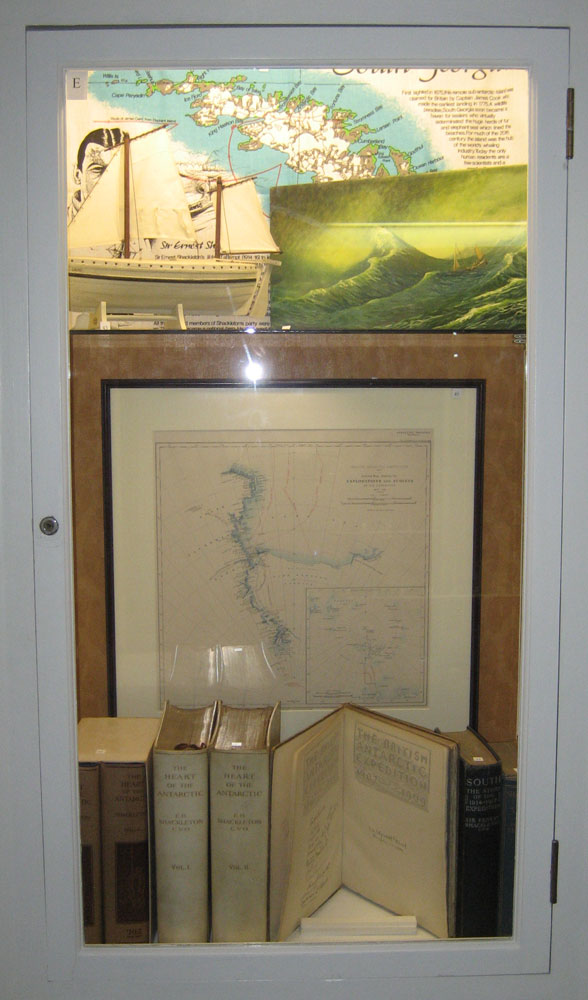
CASE E - Sir
Ernest Shackleton
42.
Shackleton – South Georgia tea towel showing the route from King Haakon
Bay to Stromness in South Georgia. Purchased at South Georgia Whaling Museum,
1999.
43. A model of
the James Caird, the
22.5 foot ship's boat that Shackleton, Worsley, Crean, Vincent, McNish and
McCarthy sailed the 800 miles from Elephant Island to South Georgia through the
roughest seas in the world. Once landed, Shackleton, Worsley and Crean had to
climb over the mountains to get help at the whaling port of Stromness. One of
the great adventures of all time. Purchased at the National Maritime Museum,
Greenwich, 2002.
44. Oil painting
by Lucia deLeiris of the James Caird in mountainous seas. Purchased from the artist, 2002.
45. General
map showing the Explorations and Surveys of the expedition
1907-09. British
Antarctic Expedition 1907. Purchased from the Royal Geographical Society, 1998.
46. A pristine
copy of The Heart of the Antarctic,
first American edition, 1909. In dustwrappers and original slipcase. Purchased
from Goodspeeds, 1987.
47. The
three-volume edition deluxe of The Heart of the Antarctic in vellum. I first bought the The
Antarctic Book, Winter Quarters 1907-1909 which was offered separately. It includes the signatures of
every member of the shore party. Purchased from Frank Hammond, 1971. I then
spent many years looking for the first two volumes offered without The
Antarctic Book so I
could "marry" them. I eventually found two volumes at Buddenbrooks in Boston in
1988.
48. South;
The story of Shackleton's last expedition 1914-1917 (London, 1919 first edition). This is
Shackleton's account of his Endurance expedition. Purchased from Joseph, London, 1974.
49. Shackleton's
Last Voyage; The story of the Quest
from the official journal and private diary kept by Dr. A. H. Macklin. By Frank Wild (London, 1923 first
edition). Shackleton died at the start of the expedition at Grytviken in South
Georgia, where he is now buried. Purchased from Gaston Renard, 1970.

CASE F -
Admiral Richard E. Byrd
[America's best
known Antarctic explorer, he led or was associated with half a dozen
expeditions to the Arctic and Antarctic. On the first to the south (1928-30)
he, with three others, became the first to fly over the South Pole (November
28, 1929)]
50. Penguin.
Pastel by Elizabeth Saltonstall of Boston, Massachusetts, a relative of Marie
Ames Byrd (Mrs. Richard E. Byrd). It was drawn from life, the same
penguin—living, briefly in Byrd's Beacon Hill bathtub—posed twice.
Purchased at The Boston Athenaeum, 1974.
51. American flag carried by Byrd over
both poles and presented to Albert Bumstead with accompanying letter written
from Dublin, New Hampshire, to North Conway, New Hampshire. Purchased from a
descendant of the recipient, 1999.
- Photos of Bumstead with sun compass and
with Admiral Byrd.
52. Ford Tri-motor Antarctic airplane
model kit. Purchased on ebay, 2003.
53. Byrd Commemorative china plate with
Ford Trimotor over the South Pole (showing an American flag being thrown out).
Hackett American Collectors Co. Purchased on ebay, 2004
54. Glass bottle. In relief: Depiction of
an aeroplane. "Byrd | Antarctic | 1928-1929 | Expedition." Purchased on ebay,
2002.
55. Chinook Bobblehead. Chinook was a
sled dog bred by Arthur Walden of Wonalancet, New Hampshire. Walden was Byrd's
lead dog driver on the 1929 expedition. Byrd's dogs were trained by Walden at
the kennels in Wonalancet. The resulting breed is the official state dog of New
Hampshire. Purchased from the New Hampshire Historical Society, 2009.
56. These hairs are from
Admiral Byrd's caribou sleeping bag. The bag, which was shedding, was stretched
out on filing case at the Byrd Polar Research Center at Ohio State University.
I just swept up a few of them. Gift of the Byrd Polar Research Center, The Ohio
State University, in 1998.
57.
Signed photograph of Bernt Balchen, the Norwegian-American who was Byrd's chief
pilot on the 1929 expedition and piloted the first plane to fly over the Pole.
Gift of Don Neel, Wilton, New Hampshire.
- Richard E.
Byrd, Wischmann's Picture Pack Gum card. Purchased on ebay, 2004.
58.
United States Antarctic Service Medal and a Byrd commemorative medal. Purchased
at auction, 1999.
59. Richard E. Byrd
lapel pin. Purchased from Explorer Books, England, 1998.
60. Back
Home. Words and music by
Irving Kahal, Sammy Fair and Pierre Norman, respectfully dedicated to
Rear-Admiral Richard E. Byrd. Purchased from Explorer Books, England, 2000.
Return of
Commander Byrd Military March.
For piano. Purchased from Explorer Books, England, 2001.
- The Snow
Cruiser was a mammoth
vehicle taken to Antarctica by Byrd on his United
States Antarctic Service Expedition. It was far too heavy and was not a
success. It remains to this day in Antarctica, probably now on the ocean floor.
This card was later retrieved from the Snow Cruiser by Denny DenHartog. Gift of
Denny DenHartog, 2000.
61. Cardboard
Box, Admiral Byrd Leather Jacket. Clara Grant brought something to my house in
this box and I was so flabbergasted that she kindly left it with me.
- Radiogram from
Little America from Dr Dana Coman conveying Christmas and New Year's greetings,
dated December 20, 1929. Gift of Don Neel, Wilton, New Hampshire.
62. Holy
Bible, from Byrd's base
station (Little America). Gift of Don Neel, Wilton, New Hampshire.
63. Little
America (1930 first
edition) Byrd's first Antarctic expedition. Limited signed edition. Purchased
at auction, 1971.
64. Discovery (1935 first edition) Byrd's second
Antarctic expedition. Limited signed edition. Purchased New York Antiquarian
Bookfair, 1971.
65. Alone (1938 first edition) Byrd's second
Antarctic expedition. Purchased from Current Co., 1971.
66. Alone (1938 first English edition) Byrd's
second Antarctic expedition. Limited signed edition. Purchased from Henry
Sotheran, 2001.
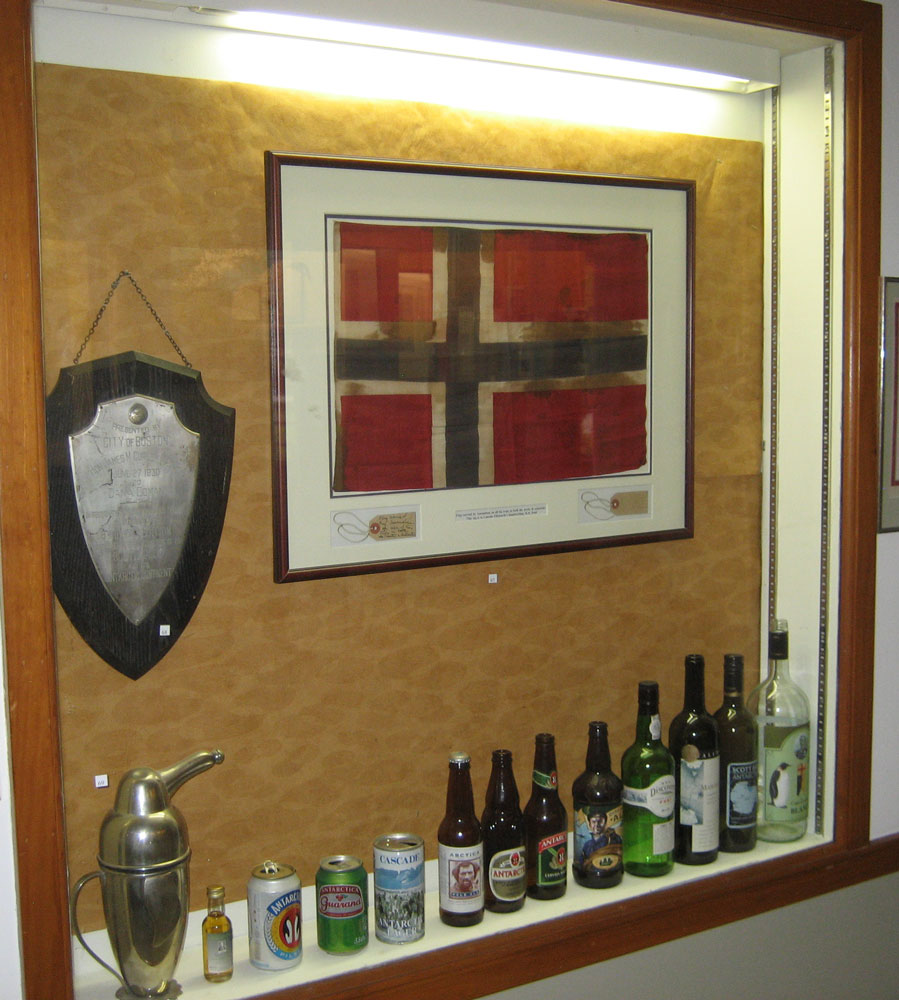
CASE G
67. This
Norwegian flag was carried by Roald Amundsen to the South Pole and over the
North Pole. He gave it to the American polar aviator Lincoln Ellsworth who, in
turn, gave it to Beekman Pool of Dublin, who kindly and unexpectedly gave it to
me.
68.
Mounted metal plaque, presented to Dr. Dana Coman, physician on the first Byrd
expedition, by Boston Mayor James Michael Curley on June 27, 1930. Gift of Don
Neel, Wilton, New Hampshire.
69. Assorted
Antarctic libations.
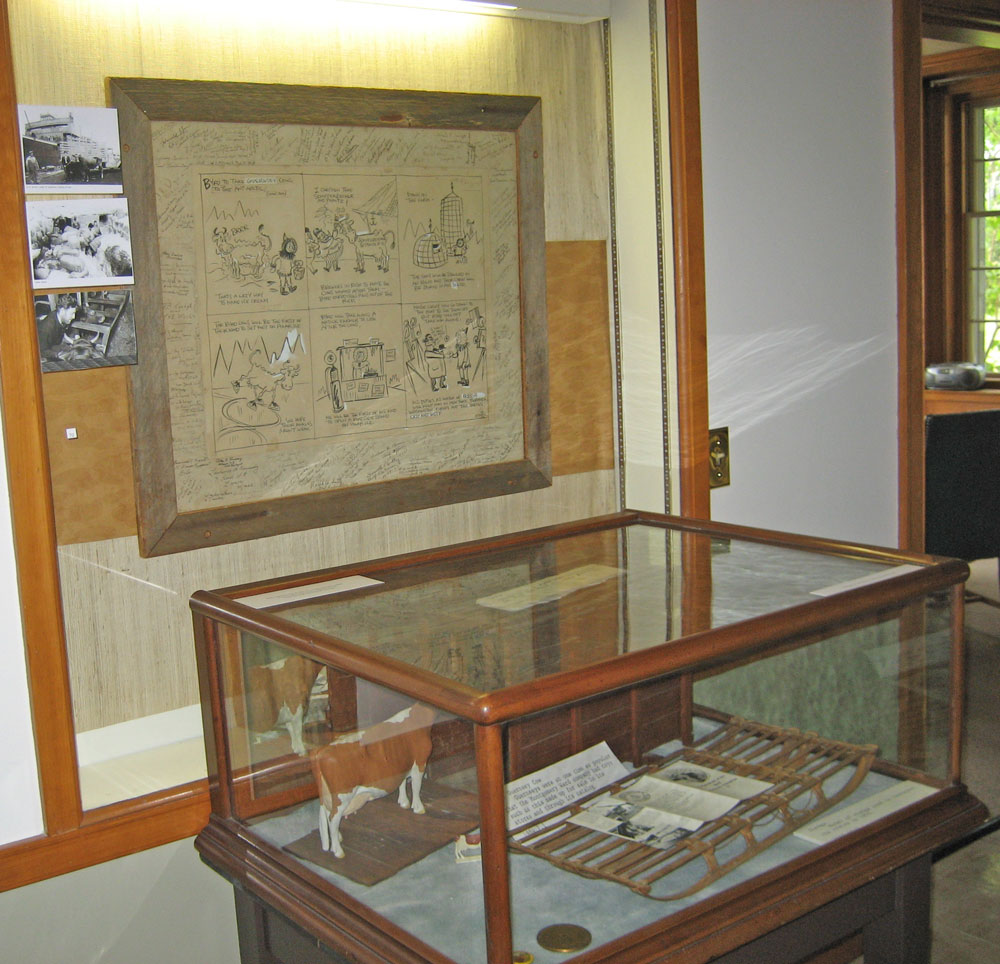
CASE H - Cows
go south!
70. This
cartoon, the models and the bronze medal were kindly lent to the exhibit by the
Peterborough Historical Society. Here's the story:
Throughout its
history The American Guernsey Cattle Club continued to make headlines but when
headlines read "Three Guernsey Cows Go to the Antarctic With Admiral Byrd"
the world had to do a double take to make sure they heard right. Yes, cows were
going on an expedition that very few men had gone before. On October 7, 1933,
Admiral Richard E. Byrd asked for three Guernsey cows to go with him in order
that they might have fresh milk. Admiral Byrd thought it would be a novelty if
one of the cows was fairly well along in motherhood, so the calf might be born
on the ice.
The cows from
Deerfoot Farm, Massachusetts, Emmadine Farm, New York and Klondike Farm, North
Carolina, were loaded on the Jacob Ruppert and set sail for the Antarctic on
October 11, 1933 from Boston. Along with the cows were provisions of sand and
straw for bedding, twenty tons of hay, twelve tons of beet pulp and two tons of
bran for the two years in the Antarctic. The three Guernsey cows affectionately
named Deerfoot, Emmadine, and Klondike made the voyage to the Antarctic having
gotten their sea legs long before any of the crew. A baby bull calf, named
Iceberg, was born 275 miles north of the Antarctic Circle on December 19th;
Admiral Byrd had hoped that the birth would truly be an Antarctic event but it
was not meant to be. The four cows made it to the Antarctic site where a cow
barn was made out of blocks of ice complete with an electric milking machine awaited
them.
Sadly, Klondike
contracted frostbite and had to be destroyed. The crew's attachment to the cows
was apparent when Cox (the crew that carried out the deed) is quoted in Admiral
Byrds book, The Discovery, "I've put away a lot of 'em, Admiral, but it
never got me before. I guess I got pretty fond of that cow." The three
remaining cows returned from the Antarctic after 22,000 miles of travel in 1935
to their original owners. Going down in history as the first cows to travel to
the Antarctic.
-Teresa Steer,
Peterborough Historical Society Staff, 2003
